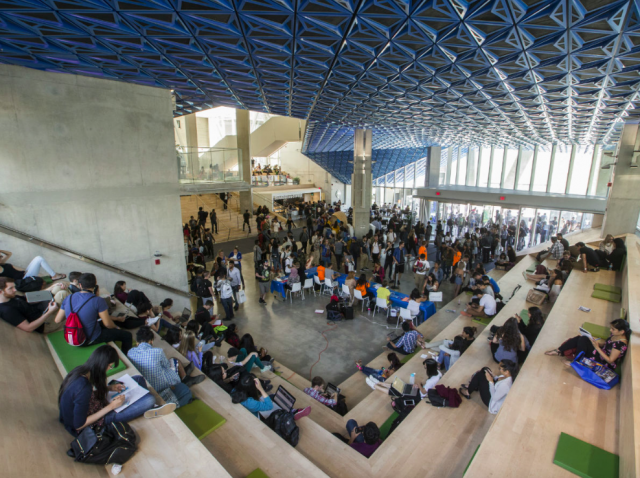Following sweeping tech cuts from the Province of Ontario, a large number of publicly funded programs were recently either cancelled or not renewed. One such non-renewed program was the Campus Linked Accelerator (CLA), an initiative that for almost five years funded more than 59 academic-related accelerator programs across the province.
“The CLAs and OCEAs have become an indispensable part of the feeder system that cultivates the high-potential early-stage startups.”
BetaKit spoke to a number of individuals involved in the CLA program, from funding recipients to those with intimate knowledge of government decisions surrounding the program, to understand what the this meant to Ontario’s tech community.
The CLA program was developed by the Ontario government, helping fund or create on-campus entrepreneurship programs at 42 universities and colleges in the province, including Creative Destruction Lab, Velocity, and Ryerson’s DMZ. Launched in 2014, alongside its sister program On-Campus Entrepreneurship Activities (OCEA), funding (for both programs) officially ended in March of this year. Sources familiar with the government program have indicated to BetaKit that public money for CLAs has run dry, with no plans from the province to renew or supplement.
The CLA program was one of many that suffered from funding cuts in conjunction with the OCE losing a large chunk of its provincial funding. BetaKit broke the news in June that following those cuts, OCE laid off a significant number of employees, with OCE’s president and CEO, Tom Corr, stepping down not long after.
Funding for Campus-Linked Accelerators was originally introduced by the provincial government as part of its Ontario Youth Innovation Fund in 2013. Along with the complimentary OCEA, CLA was created as a two-year program that would help invest an initial $25 million in the “entrepreneurship hubs on postsecondary campuses” that began to pop up en masse at the time. After its inaugural year, the program was extended through to March 2018.
According to some of the funding recipients and entrepreneurs involved in the programs, CLAs had a strong trickle-down effect, supporting the Ontario startup ecosystem.
“The only reason I started my incubator is because of the Campus-Linked Accelerator program,” said Helen Kontozopoulos, who co-founded the University of Toronto’s Department of Computer Science Innovation Lab (DCSIL) accelerator, in 2015.
“We were able to help so many teams across a whole ecosystem because of this CLA money,” she stated, pointing to companies like ROSS Intelligence, and Blue J Legal, which was co-founded by three members of U of T’s Faculty of Law.
While the cheques CLAs received were not necessarily large, sitting somewhere around $600,000 to $950,000 per CLA, the program’s model, which required matching dollars and in-kind investment, added a lot of value for budding startups. The funding, distributed through the OCE, was put towards providing access to tools and equipment, delivering training, mentoring, startup funding, and connecting young entrepreneurs with investors.
No surprise ending
Based upon conversations with BetaKit, the CLA funding running dry came as no surprise to those involved. After being extended to 2018, the then-Liberal provincial government decided to extend the program for one more year, until March 2019. Sources with knowledge of the decision-making process have indicated to BetaKit that prior to the Conservative government coming to power, the provincial Liberal government had the option to extend to program, but chose not to, leaving it open for the Ford government to make the decision.
The CLA program was never meant to last, however. The idea behind it was to create an environment that encouraged CLAs to find new and additional sources of funding.
“Part of what makes us one of Canada’s most successful entrepreneurship programs is the diversification of the support and funding.”
“The Campus-Linked Accelerators program has been an asset to the growth of Ontario’s innovation ecosystem,” said Abdullah Snobar, executive director of Ryerson’s DMZ, which received CLA funding along with the university’s other innovation ‘Zones’. “The recent cuts signal a moment for incubator and accelerator programs in Ontario to become more self-reliant as our innovation economy continues to grow and be recognized on the global stage.”
While some of the larger CLAs, such as the DMZ, have been successful at procuring private and other funding sources, multiple sources familiar with the program have indicated to BetaKit that it is the smaller CLAs and communities that will now suffer.
Accelerators that received funding spanned the province, from The Forge at McMaster University, to London-based LEAP at Fanshawe College, and St. Lawrence College’s Innovation Hub. The program provided funding, such as $950,000 grant to OCAD University’s Imagination Catalyst hub, to accelerators that often see less support than their more well-known counterparts. The idea was to help them offer support and guidance to startups and entrepreneurs that don’t typically have access to the resources that come with being in large urban centres or well-funded programming.
Jay Shah, director of Velocity, who said the Waterloo accelerator prepared for the program coming to an end, told BetaKit, “part of what makes us one of Canada’s most successful entrepreneurship programs is the diversification of the support and funding that makes our activities possible.”
He pointed to Velocity’s recently launched venture-fund enabling investors to fund early-stage startups, as well as federal funding and private partnerships that have helped the accelerator financially prepare for the provincial cut.

Fellow Kitchener/Waterloo-based The Accelerator Centre, which has received millions of dollars in federal support for its incubation and mentorship programs, told BetaKit that it was also prepared for cuts, but that the CLA provincial funding accounted for just two percent of its overall budget last year.
Smaller CLAs, such as Centennial College’s ACCEL (Accelerator for Centennial Community Entrepreneurs and Leaders), relied more heavily on the provincial government program. Jonathan Hack, executive director of applied research, entrepreneurship, and innovation services at the college told BetaKit that in light of the loss, the college will take on the responsibility for funding its CLA, which will run for another year then be reviewed in March 2020 to assess its usefulness.
This will likely be the case for many CLAs. The responsibility to fund and continue running these accelerators will now fall to the post-secondary institutions they are associated with. The challenge, especially for medium and small CLAs, is that those academic institutions are also currently facing major questions around the availability of funding thanks to provincial changes in tuition fees and OSAP.
The CLA trickle-down effect
A report from 2016 about the CLA and OCEA programs, conducted with support from OCE, emphasized a positive impact from the government’s funding. It found that in the two years since program launch, 2,214 startups were created or supported with the help of CLAs and OCEAs, with 96 percent of young entrepreneurs surveyed attributing a part of their success to participation in a CLA or OCEA program.
“I do worry [about] how do we not lose these startups. It’s usually what keeps up at night.”
The report, by Sweden-based global innovation hub researcher UBI Global, also found that 58 percent of CLA and OCEA supported startups raised follow-on investments, with the programs reaching more than 280,000 students in the two year period.
“The CLAs and OCEAs have become an indispensable part of the feeder system that cultivates the high-potential early-stage startups that graduate to other parts of the ONE [Ontario Network of Entrepreneurs], including RICs [Regional Innovation Centres] and angel investment networks,” the report stated.
However, the report also hinted at the fact that the CLA and OCEA programs were not generating revenue. It noted that the programs “are projected to ‘break-even’ by the end of 2016/17,” assuming that “new provincial tax revenues” would cover the costs of maintaining the programs. The report projected CLAs to “become net contributors to Ontario’s fiscal bottom line” in the years following.
Despite the report’s glowing recommendations to continue to grow and fund CLAs and OCEAs, questions around their usefulness persisted. A Globe and Mail story from 2016 found that despite receiving CLA funding, “many Ontario universities have struggled to design effective entrepreneurship programs for students…raising questions about how institutions can meet the government’s hopes for an increase in such strategies.”
Some of the people who spoke to BetaKit about the CLAs argued that the cuts to these programs were understandable, with accelerators having ample time to come up with a model that worked over the almost five years the program was active. Others that spoke to BetaKit acknowledged that the program was not perfect, but indicated that the role CLA funding played touched many aspects of the Ontario tech ecosystem, especially when it came to supporting early-stage startups.
RELATED: How MPP Vic Fedeli’s “demotion” could affect Ontario’s tech and innovation sector
While it is hard to determine the exact effect the CLA and OCEA programs had on the Ontario tech ecosystem en-large since 2016, it should be noted that the programs were also feeders for other OCE and government funding. Having participated in a CLA or OCEA program was a requirement in order to access government funding from the likes of Market Readiness and SmartStart Seed Fund, which have been called critical early-stage programs for commercialization. In fact, the websites for both programs still state (at time of publication) that in order to be eligible, applicants must “currently or previously” be affiliated with a CLA, OCEA, or Regional Innovation Centre, (which includes MaRS Discovery District and Communitech).
“With all this change in dynamics I don’t want to lose this [early-stage support],” said Rich McAloney, director of technology management and entrepreneurship for the University of Toronto’s Impact Centre, which also received CLA funding.
“So we’ve got to all be startups, we’ve got to find ways to support this, but I do worry [about] how do we not lose these startups. It’s usually what keeps me up at night. And the change in the CLA does have a ripple effect down to that level whenever there are any of these changes,” he said. “We’ll survive without that if we have to, [but] we can do a lot more if that was there.”


